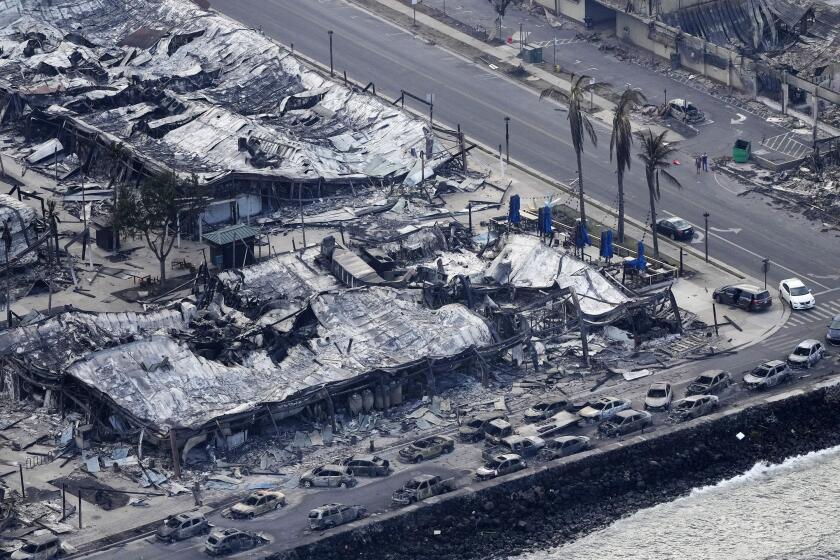A historic banyan tree burned in Maui’s wildfires still stands, but can it survive?

- Share via
In 1873, an exotic banyan tree was planted in the port town of Lahaina, a major hub for the then-Kingdom of Hawaii. At the time it was only 8 feet tall.
Today, its branches extend over 60 feet high and stretch even wider, providing shade to nearly two-thirds of an acre, according to the Lahaina Restoration Foundation. It is listed as the country’s largest banyan tree, preserved and cared for by the historic town on Maui, where it’s become a landmark and a community gathering space.
But it may now be facing its final days, after a string of wildfires swept across Maui last week, leaving dozens dead and many parts of the island scorched, especially Lahaina.
The banyan tree remains standing, appearing to have withstood the flames, ash covering its gnarly branches and multiple trunks, against a backdrop of rubble and items charred beyond recognition, according to accounts from the decimated town.
But experts worry that the heat of the devastating fire could bring an end to the 150-year-old tree, a nonnative species that doesn’t have any natural defenses against flames.
“I don’t think that has survived, seeing the buildings all around it burned to the ground — that’s a hot fire,” said J.B. Friday, an extension forester with the University of Hawaii, who has reviewed images of the tree but hasn’t assessed it in person. “It doesn’t look like it will come back from it.”
Wind-whipped wildfires raced through the heart of the island of Maui, killing 53 people, forcing evacuations and gutting much of the historic town of Lahaina.
Kimberly Flook, deputy executive director for the Lahaina Restoration Foundation, which is dedicated to preserving the town’s history, remains positive.
“Looking at the photographs, I feel there’s reason to hope,” she said, pointing out that multiple wooden benches under the tree also survived the blaze. But she said there’s just no way to know yet how severe the damage was to the tree: “There’s certainly evidence of scarring, and a lot is covered in ash,” she said.
“A tree that’s gone through a fire that has even partial viable material can survive,” Flook said. “It’s hard to tell how much of a shock it took.”
She said with a viable branch or two off the main trunk — if it’s not too burned — the tree’s system of aerial roots could foster regrowth.
“If it can pull through, it would be an absolutely amazing symbol,” said Flook, who spoke from her home in Wailuku, a more eastern town that was not affected by the fires.
Over the weekend, an arborist team was able to survey the tree but hasn’t yet shared any formal report, Flook said.
“The general feeling is that there are signs of hope along with evidence of damage,” Flook said in an email Monday. “A plan is being put in place to care for the tree to give it the best possible chance to survive.”
Of the few buildings still standing in Lahaina, most have been reduced to skeletal frames, walls surviving because they were built with coral block — an island brick replacement — or cement, she said. The old Lahaina Courthouse, adjacent to the tree in Banyan Tree Park, is “just an empty box now,” Flook said.
Her foundation, which is raising funds to help Lahaina recover, has been trying to assess the extent of loss to its museums and registered sites, but she said the history lost is everywhere.
“Lahaina was a nationally designated historic area, as well as two local historic areas,” Flook said. “There’s dozens of historic buildings that have been lost that were just places you lived your life,” such as hotels, restaurants and ice cream shops.
U.S. Sen. Brian Schatz, who represents Hawaii, posted an update Thursday from Lahaina’s Front Street, which is typically bustling with shops and restaurants interspersed with green spaces and ocean views.
“Total devastation,” he said, standing among piles of wreckage. “The sugar mill is still in place. The lighthouse is still in place. The banyan tree looks to be still standing, but very little else.”
Banyan trees are not native to Hawaii, hailing from the Indian subcontinent. As with many of the islands’ native trees, flames can easily “topkill” them, Friday said, which means the roots might survive and resprout, but the above-ground portion of the plant is scorched to death.
As firefighters finally made progress on California’s largest wildfire of the year, national park officials and ecologists are preparing for irreversible habitat losses.
“It could possibly survive and sprout up from the roots again,” Friday said of the banyan tree, but that process would take decades to grow into a sizable tree. “It looks like it was a really hot fire.”
Friday, who’s worked on wildfire issues across the islands, considers this one of the worst.
“This is the first time it’s really hit an urban area like this,” Friday said. “This is just heartbreaking.”
He said an explosion of nonnative grasses on the islands, coupled with less land management as agriculture declined, has provided more fuel for wildfires, with extreme weather brought on by global warming aggravating the problem.
“Rainier rainy periods, more severe drought, are all the climate drivers,” Friday said. “The wildfire situation is getting worse and worse.”
More to Read
Sign up for Essential California
The most important California stories and recommendations in your inbox every morning.
You may occasionally receive promotional content from the Los Angeles Times.
















